From Phrase to Phrasing
A Classical Perspective
Chapter 4 – Case study 2: Haydn Hob.XVI:16
Though many Classical compositions are in fact quite clear-cut structurally I also want to tackle a more challenging piece. The music of Beethoven and late Mozart can be very complex but generally has a more regular foundation than the music of early Haydn and C. P. E. Bach. As a test case I decided on Haydn’s Piano Sonata Hob.XVI:16. It is a quirky piece, maybe that is why its authorship is nowadays debated, and even the title is disputed, Sonata or Divertimento. Haydn or not, the piece seems to defy regularity. For a complete score of the first movement, see appendix 2.
Complete first movement by Jan Willem Nelleke - fortepiano (McNulty)
My original point of departure was to apply the discussed theory but I found that to be insufficient for an in-depth view. I will bring in elements that are not mentioned in treatises but are based on studying scores and noticing recurring patterns. Of the books used, William Caplin’s Classical Form deserves special mention.40William E. Caplin, Classical Form: A Theory of Formal Functions for the Instrumental Music of Haydn, Mozart, and Beethoven, New Ed edition (New York; Oxford, 2000).
Bar 1-10
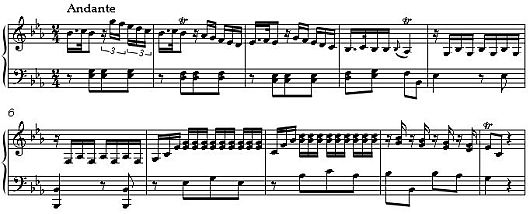
Figure 44: Haydn, Ho.XIV:16 - opening statement.
The opening statement has two repose-moments (bar 5 and 10), therefore there are two phrases but are they really two 5-ers? Bar 5 is both the end of the first and the beginning of the second phrase, suggesting bar suppression from something like:

Figure 45: Opening without bar suppression.
The bar-suppression prevents an empty moment, but why actually? An empty moment can be of great effect, keeping tension and raising expectation. But here the rather bland material that follows cannot fulfil that expectation. We would either expect a new theme (but that would be too early in the piece) or a repeat. Repeating would create a conventional open-close, or question-answer structure. (I will refer to this common construction of two even parts as a bicolon, the background to this is explained in chapter 6).
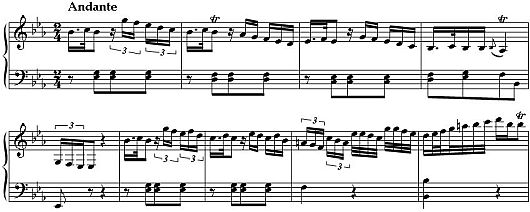
Figure 46: Opening turned into a bicolon.
The composer did not choose this obvious solution: maybe due to the ‘repetitive’ character of theme itself he did not want to repeat it immediately, maybe he felt that the stable and conventional construction of the bicolon contradicted the exploratory character of the theme, or the composition would develop too quickly in relation to the length he had in mind. But in essence this bicolon is the foundation of the first section.
The bar suppression he actually wrote allows for less significant material to follow. According to Koch we count the suppressed bar double, but that would make the irregular but symmetrical 5 + 5 into an unbalanced 5 + 6. However, the first phrase feels almost too long and could well be considered an extended 4-er, repeating bar 2 at an other step of the scale (see Fig. 47). This repetition also explains aforementioned repetitive character.

Figure 47: First phrase without extension.
The phrase-rhythm is thus theoretically an even 4 + 6 though this feels contrived to me, and probably to the composer as well because bar 5-10 is so obviously in even bar numbers as if to compensate for the irregular beginning.
There is also another way of looking at this. Johann Friedrich Daube (1733-1797) uniquely does not even mention cadences in relation to phrases.41Johann Friedrich Daube, Anleitung zur Erfindung der Melodie und ihrer Fortsetzung, 2 vols (Vienna, 1797), i. For him the melodic content shapes music into phrases (only 4-ers or 8-ers are allowed). In his examples he makes a fairly clear change every fourth bar by changing melody or texture without necessarily having the same regularity in cadences. I have found no specific source for using texture in structuring music but it often plays an important role. One of Mozart’s favourite tricks is to seemingly break phrase-rhythm by changing texture too early.

Figure 48: Mozart, Violin Concert in D, K.218, mov.1. Texture changes one bar early.
We see something similar here in the Haydn where texture structures the music into 4 + 2 + 4 bars even though the cadences are at different places.
There is another reason the first phrase feels slightly aimless. Harmonically it is set up to lead to the dominant:

Figure 49: First phrase turned into a dominant-phrase.
This is a perfectly regular phrase and it would be easy to add a complimentary phrase leading back to the tonic—a conventional bicolon again. Instead of letting the phrase go to its obvious destination, he is now forced to add material because going to the tonic takes one step extra. This longer road explains that we tend to find extensions more often in tonic phrases than in dominant phrases. Another solution would be to distribute this longer road differently by making the harmonies move earlier. Thus we often see, with parallel tonic and dominant phrases, that the tonic one moves towards the cadence earlier than the dominant one, possibly like:

Figure 50: First phrase reshaped by change in harmonic rhythm.
Again, he did not choose this. Personally I like the quirkiness of the extension, it has a more recognizable character than the bland 4-er, and that is the point of course. If Koch says a repetition needs to be ‘worthy’ and represent the expression of the phrase in a high degree, the other side of the coin is that there must be a need to enhance the character: as if the composer felt he had not been clear enough–in that sense extensions can be viewed as rhetorical devices.
The second phrase has been extended as well, the first 2 bars can be left out without any problem:

Figure 51: Bar 5-6 can be cut out.
But this would make it sound like an appendix rather than a new phrase, the similarity of the left hand rhythm emphasizes that even more. We could indeed read the 6 bars as 2 appendices (2 + 4 bars) to the first phrase but the strong cadential move into the sub-dominant seems to imply it is a phrase though. The interpolation of (the original) bar 5-6 is therefore functional: it favours a phrase-feeling by having the character of something new opening up, helped by the move away from triplets and left hand rhythm. The 2 phrases compliment each other: searching versus stabilizing—except for the unusual last cadence. The I6 undermines the expected perfect cadence and associated close of a period: a significant change in punctuation! It announces that what follows is not a repeat of the beginning as bar 11 might suggest, but rather a continuation like a semicolon, confirmed by a modulation to the dominant.
Bar 11-17
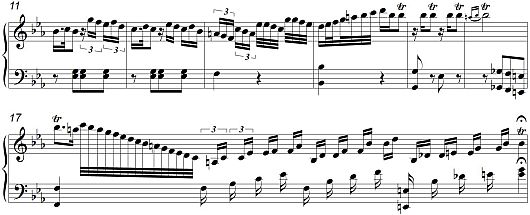
This third phrase gets extended significantly in bar 15-17, leading to the dominant of the new key using the repetition of a rhythmical motif (trill). Two bars would have been enough though, making it an even 4 + 2 bars:
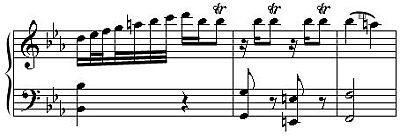
Figure 52: Bar 14 with minimal extension.
Instead he expands the cadence, adding weight to it by adding a bar. The use of chromatics contributes further to a feeling of weightiness, the quick succession almost causing an implied ritardando. From here he could have cut straight to bar 18 but he adds another extension in the form of a cadenza, further raising the level of expectation. The cadence looks free but is essentially structured and could have been written out as a normal 4-er with an expansion again at the cadence.

Figure 53: Cadenza written out as a phrase.
After so much delay it would have been a damp squib if the cadence was simply resolved. Instead, he suppresses the resolution bar and plunges into completely different material. Indeed, after a build up like that we need such a big contrast that even a tempo change is warranted–a sort of alla breve.
Bar 18-31
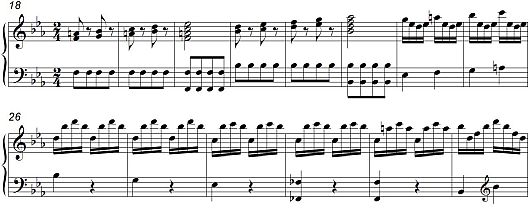
Suddenly we are in the realm of 3-ers, three in a row, the third one being a variation of the previous two with the melody in the bass and added figuration.
But if these are 3-ers, where are the cadences to indicate the end of a phrase? Regular 3-ers would have been like the example below,

Figure 54: Regular 3-ers with cadences.
but as it stands there are no cadences, hence no repose-moments. Theoretically you can presuppose bar suppressions but that seems an artificial way of making the theory fit.

Figure 55: Bar 18-23 with hypothetical bar suppression.
Though, without going so far as bar suppression, it is an interesting point that some of the dominant tension is probably released into the next bar.
We can also decide that texture determines these to be 3-ers, or we could even declare these bars to be a string of appendices. Koch’s examples show series of appendices that are far longer than the phrases they prolong but here they are far too important thematically to be considered as such.
I would like to look at this section in a different way. Having introduced the bicolon before, I now want to add the tricolon (more about this in chapter 6). This is the almost archetypal Classical construction of the tripartite Bar form, or short-short-long. I find it peculiar that none of the treatises specifically recommends this construction or gives it a name, though many if not most of their examples have this shape. Bar 18-31 is fundamentally a tricolon which is clearer when simplified.

Figure 56: The tricolon at the heart of bar 18-31.
The advantage of looking at it this way is that the length of the individual 3-ers is now defined in relation to a bigger shape rather than by their individual identity: essentially one phrase with three phrase-members. Simplifying it one step further, incorporating the supposed tempo change in notation, shows the perfectly regular foundation (Fig. 57). Two beats have been cut out to create 3-ers, with great musical impact, and the penultimate bar has again been expanded.

Figure 57: Tricolon in hypothetical regular bar structure.
Bar 31-38

The changes in phrase-rhythm are remarkable, maybe even a step too far, and need to be stabilized. In the next bars even numbers are back in abundance: a 4-er in the form of a progression, followed by a 2-er to confirm the key, and 2 added chords to confirm the end of the section. Since a progression by nature can keep continuing, the choice for 4 bars is probably deliberate to restore balance; it could just as easily have been 3 or 5 bars (see below).

Figure 58: With possible 3-bar progression.

Bar 39-end
The next section is surprisingly regular. It starts with two times 2 bars, a sort of modulating sequence in the form of a bicolon. From bar 42 he could have cut to bar 47, instead he attached a 4-er: the descending sequence balancing out the previous ascending sequence. If we would embellish the fermata that would provide even an extra extension. Next (bar 47) a 5-er that includes an extension by a repeat (bar 49), and a series of appendices identical to the first section. The last section is identical to the second, only in the tonic this time.
With all these extensions I was not surprised that the first section counted a very odd 41 bars (I count the cadenza as written out) but the almost identical number of bars in each section (20 + 21 + 19 + 21) seems remarkable to me–with a little cadenza in bar 48 it could even be made into a symmetrical 20 + 21 + 21 + 20.